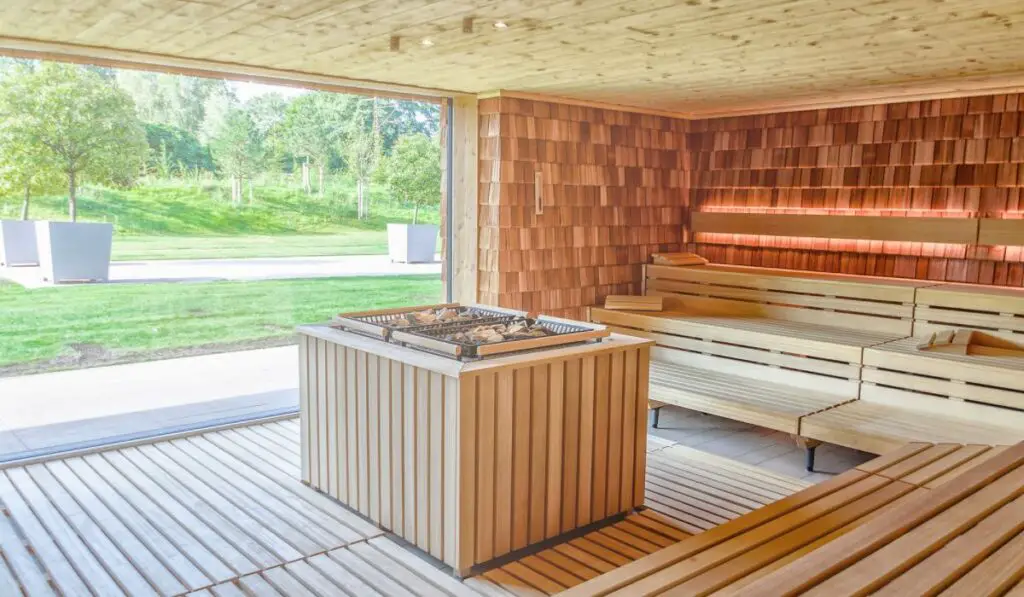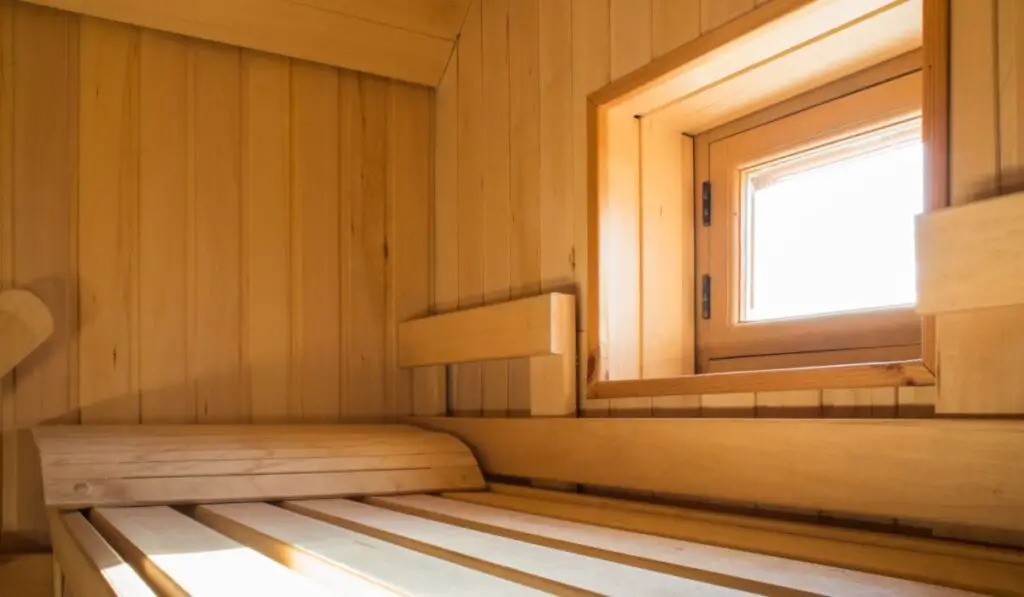If you’re building a sauna, sooner or later you’ll face an important decision: to have windows or not to have windows. Some people love sauna windows while others prefer a windowless sauna. Keep reading to learn the pros and cons of sauna windows, window and glass types, cost, and tips for window installation.
You can put a window in a sauna, but they aren’t standard. A small window can provide a nice view, but the glass will lose heat and make it harder to maintain a consistent temperature. Some people prefer installing a small vent for temperature control instead of a functioning window.
The decision to add windows to your sauna or go without is a personal one. While opinions vary greatly as to whether or not sauna windows are a good thing, the choice is truly yours. Here’s what you need to know about sauna windows to help you decide.
Do Saunas Need Windows at All?

The short and simple answer is no, saunas don’t need windows. However, saunas can absolutely have windows, and many sauna users prefer them. Some sauna components aren’t an option and are required for proper sauna functioning, safety, and cleanliness (how to maintain a sauna in our guide).
Other parts have mixed opinions, and you’ll want to thoroughly research what your sauna truly requires. In a separate article, We’ve discussed whether or not saunas need drains, for example, but where do sauna windows fall on the spectrum from completely unnecessary to an absolute must?
The truth lies somewhere in the middle. We’re about to help you decide if your sauna needs windows.
Why Saunas Don’t Require Windows
Windows contribute nothing to the functioning of the sauna itself. In fact, a poor-quality window will detract from your sauna experience. A window made with the wrong type of glass (more on this below) can cause heat to escape.
This means that your heater will have to work harder to maintain the proper high temperature, and you might even notice that your sauna just doesn’t feel hot enough.
This, of course, defeats the main purpose of a sauna—to make you heat up and sweat. A sauna’s many benefits happen because of the heat. If a window leaks heat out and lets cooler air seep in, you’re losing potential advantages.
Some people prefer the dark, cozy space of windowless saunas and believe they feel more authentic and relaxing. For some who use saunas during the daytime, the bright, natural light streaming in through a window is too stimulating. So, too, can be a view of whatever is outside (especially if it’s rather unsightly).
Climate is a factor to consider, too. Windows placed on an exterior wall, especially those without the right kind of glass, can’t always withstand the heat extremes between the hot sauna interior and the frigid outdoor temperature. Some glass will crack under this type of stress.
Why You Might Want Windows in Your Sauna
Windows can play a part in your overall sauna experience. You might decide that they would enhance your own sauna. Windows can let in natural light and make your sauna feel cheery, welcoming, and inviting. Saunas are typically small rooms, so adding a window can make them feel more airy, spacious, and less claustrophobic.

This roomy sensation can be achieved without an outdoor window. If your sauna includes an adjacent changing room, placing a window between the hot room and changing room adds some extra light and spaciousness without risking inefficiency and letting in cold outdoor air.
This type of window is often called a candle window. In the days before electricity, people would place a candle on the windowsill between the sauna and changing room to provide light. Placing a small window in your sauna door can be convenient.
People can look inside before entering, and if someone knocks on the door or you want to check on something outside, you can look through the window rather than opening the door and allowing heat to escape.
If you’re placing your sauna in an area with attractive surroundings, adding a window allows you to take in natural beauty. Simply viewing nature has been shown in studies to promote relaxation and stress reduction. If you’d enjoy gazing outside while you relax in your sauna but don’t want to compromise privacy, you might consider adding a transom window.
These are decorative windows placed high enough in a room that they allow in light without letting peering eyes see anything inside. While transom windows will restrict your view a bit, you’ll still receive plenty of natural light and also experience seclusion. If you’ve decided that you want windows in your sauna, the next choice is whether you want to be able to open them or not.
Should a Sauna have Fixed Glass or Functioning Windows?
Whether your sauna has a fixed glass or functioning window is largely a matter of personal choice guided by practical concerns. Fixed glass windows don’t open while functioning windows can open and close as you desire. Because you don’t want the heat to escape while you’re using your sauna, you’d never open your window while the sauna is active.
The purpose of a functioning window is to help reduce the temperature and humidity after your session. However, you can get the same result by installing a physical air vent made especially for saunas. The Fdit Cedar Sauna Gable Vent Kit (on Amazon) is inexpensive, attractive, and properly vents your sauna so you don’t have to open windows.
Sometimes, people use their sauna for other purposes, such as to double as a guest room. If you plan to use yours for things other than its primary purpose, a functioning window can keep the air fresh. Carefully select functioning window components like locks and handles.
Avoid interior parts made of vinyl, as vinyl degrades and cracks over time because of the heat. Also, stay away from metal components because metal heats to dangerous temperatures and can cause burns. Wood window parts are the preferred option for functioning sauna windows.
Regarding efficiency, fixed sauna windows are better than functioning ones. They remain tightly sealed to minimize air leakage. You also won’t have to worry as much about window damage or breakage (and costly repairs and replacements) because they are better able to hold up to extreme temperatures without cracking.
What Kind of Glass should a Sauna Window be Made of?
Using the right kind of glass is crucial for sauna windows. Improper glass will be inefficient, causing a lot of heat to escape. It will also easily break in the extreme temperature difference between the inside and outside the sauna room.

Tempered glass is glass that has been toughened in a process involving high heat—is a must in a sauna window. It’s energy-efficient and will retain your heat. Considered a safety glass, it is four times stronger than regular (annealed) glass.
Also, if it does break (it is still glass, after all), it cracks rather than shatters. While you’ll still have a broken window that looks like a gigantic spider web, you won’t have to deal with sharp glass shards littering your sauna floor and benches. There are different types of tempered glass to consider.
- Single-glazed tempered glass is a single pane of glass either 3/32’’ or 9/16’’ thick. It’s sometimes used because it’s stronger than annealed glass and is less expensive than insulated tempered glass. However, it loses a lot of heat. Your heater will have to work harder (costing you more money to operate). You also won’t feel the steady, consistent, benefit-inducing heat you probably want in a sauna.
Single-pane tempered glass does have one advantage. It is less likely to fog up than double-paned glass. Condensation can form on the surface, but it doesn’t get in between the two panes where you can’t wipe it off.
- Insulated tempered glass (aka double pane tempered glass or double-glazed tempered glass) is made up of two pieces of glass sealed together with a layer of air or other gas between them. You can get this glass made with spacers to maximize heat retention and minimize moisture build-up. While it’s considerably more expensive up front, you will have lower operating costs and a more pleasant sauna experience.
- Tinted glass. Tinted glass can slightly improve the heat efficiency of your windows as well as buffer the intensity of outdoor light. This choice is really more about personal aesthetic preference than functionality. Keep in mind that adding tint will increase the cost.
Never use plexiglass in a sauna window. It is inefficient, can’t withstand the high sauna temperature, and it can emit an unpleasant smell when exposed to heat. Considering that one of a sauna’s many benefits is the removal of toxins, you don’t want to breathe in harmful fumes while you’re sauna bathing.
How Much Do Sauna Windows Cost?
Sauna windows come in a range of prices. The cheapest option is to custom-order your glass from a local glass company. Depending on size and type of glass, this can run about $50, give or take. You will have to buy and make the frame separately, though.
Buying a sauna window kit is more expensive but more convenient as you’ll get everything you need and only have to secure it in place. The cost for a sauna window kit depends on size and type of glass but they can run from around $160 to over $235 per window.
How Big Should the Sauna Window Be?
Size depends largely on function. Generally, smaller is better in a traditional sauna for maximum heat retention and privacy. A 12” x 12” door window will usually be sufficient. If you have an infrared sauna, you can generally have larger windows.
Because they directly heat your body by penetrating your skin instead of heating the room, some infrared sauna kits like this one (on Amazon) are mostly windows.
How Do You Install a Sauna Window?
These are the basic steps for installing your own sauna window. However, if you’re new to window installation, it may be wise to hire a professional. Because sauna windows aren’t required for a great sauna experience, you’re free to decide if you want windows and, if so, what they’ll be like. Go with what pleases you, and enjoy your sauna!
- Decide where you want your window. Never place a window directly above your heater or in the way of seating. It’s best to place it between studs for maximum support.
- Cut your opening about ⅛” to ¼” bigger than your window. Sand the edges.
- If it didn’t come with a frame, build a wood frame around it. You need a top and bottom plate and studs on the sides.
- With another person supporting the window, place it into the place. Use a level for proper placement. Drill pilot holes into the wood for your screws and then secure the window framing to the studs. Use silicone to fill gaps between the glass and the frame.
- Add insulation around your window and seal it with foil wrap and tape.
- Trim as desired.
